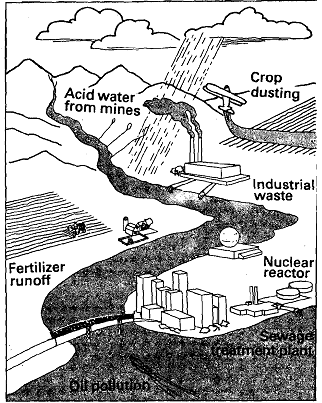Water Pollution
Pollution of fresh water is one of the most serious environmental problems of the world as a whole. In our country most of the rivers and lakes are polluted and their waters are unfit for drinking. According to an estimate nearly 2/3rds of all illness in India is related to water - borne diseases such as typhoid, hepatitis, jaundice, cholera, diarrhoea and dysentry. About 73 million workdays are lost due to these diseases every year. Pollutants from different sources enter surface waters as depicted in Fig. 16.3. Now we shall take up these sources one by one and discuss how they cause pollution.
i) Water is required in large quantities in industrial processes, for cooling. washing, diluting chemicals or cleaning purposes. Power plants, fertiliser factories, steel mills, paper mills, refineries, sugar factories and automobile factories are examples of industries which mostly dump their wastes in rivers or into the sea. It is not a rare sight to see the used water with foul smelling chemicals just standing around the factories as a symbol of total disregard of civic responsibility.
ii) Community wastes (sewage and garbage) from urban and rural settlements account for four times as much water as industrial wastes. Most of these wastes are discharged untreated into the water courses. Out of India's 3119 towns and cities, only 217 have partial (209) or full (8) sewage treatment facilities. It is not unusual to find whole localities where waste water, with all its filth, just stands around the houses where poor people live.
iii) Water that flows on the surface of cultivated fields where fertilisers, pesticides, insecticides and other agrochemicals are used, contributes much to the pollution of water. This water, on absorption also pollutes the underground sources.

iv) Nuclear and thermal power stations use large quantities of water for cooling purposes. They discharge the resultant hot water often containing chemicals, into water streams. This results in increase in temperature of the water of the stream, which is injurious for fish, and other aquatic organisms.
V) Pollution of river water by ferries which leave a certain amount of oil on river surfaces and similar pollution by ships on the high seas interferes with the supply of oxygen needed for plants, and animals such as fish etc. in water. Offshore exploration for petroleum, and accidental oil spills cause similar problems for under-water life.
vi) Acid water from mines, and also from rain pollutes water in rivers and in the sea.
vii) Suspended particles in the air, such as the pesticides sprayed through an aircraft are brought down into the water bodies by rain and thus cause pollution of water.
So far, you have seen, how water on the surface of the land is polluted by various means. Now, let us talk about our underground water resources and see if they are free of pollution. Ordinarily one would expect underground water to be free of pollutants, because bacteria and deca y-causing fungi present in the soil can remove most organic contaminants beforewater reaches the water body underneath the soil. But sometimes, the underground water is polluted with heavy metals, nitrates, chlorides etc. You may wonder how do pollutants enter the groundwater? Previously, industries were accustomed to running waste waters to pits. There the pollulants would seep into the ground. Also some of the wastes, were buried in deep wells made in the soil. from which pollutants were constantly discharged. Anolher reason is excessive use of fertilisers in the fields, which gradually seep down to the ground water. Having seen how our water resources both on surface and underground, are pollutt.d, we shall now discuss the effects of water pollution on the life forms. Some of the worst problems have been created by pollution of streams. with heavy metals such as lead and mercury coming out of industrial wastes. These pollutants make bathing and drinking water from such sources dangerous. Fish from such sources are also not safe to eat.